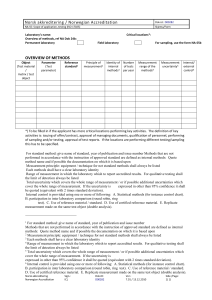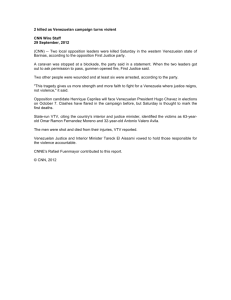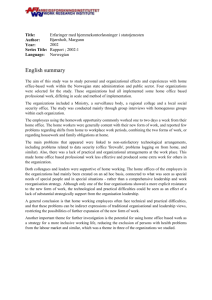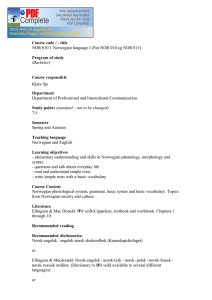Managing Projects
advertisement
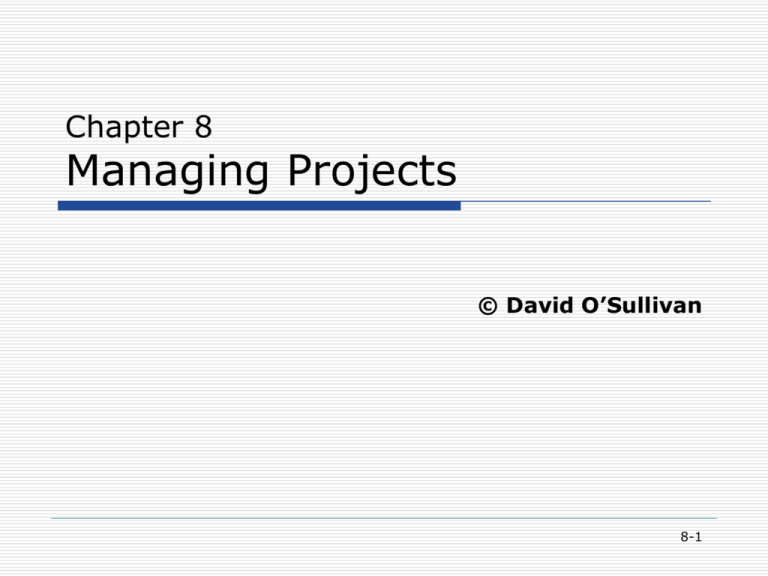
Chapter 8 Managing Projects © David O’Sullivan 8-1 Reflections What is creativity? List and explain five graphic-based tools that can be used for generating ideas. Where do ideas come from? Explain the mind mapping tool. How are failure modes scored in the failure mode effects analysistechnique? Detail a simple form for capturing critical data for an idea. Explain the importance of lead users in generating new ideas. 8-2 Activities [Discussion of selected student ‘Activities’ from previous chapter] 8-3 Learning Targets Outline the key stages of a project life cycle Understand the types of investments necessary for projects Explain the importance of risk management in projects Construct a simple cost–benefit analysis for a project Understand a number of tools for managing projects Understand the six stages of the buyer experience life cycle Detail a simple form for capturing critical data for a project 8-4 Projects and Portfolios Project Management Managing an individual project Managing project resources Achieving project goals Portfolio Management Managing a group of projects Managing organisational resources Achieving organisational goals 8-5 Semantics Projects Initiatives Actions Tasks Portfolios Programs Initiatives 8-6 Projects A unique, nonpermanent, goal-centered activity with a predefined life cycle, constrained by cost and resource availability Sample projects related to innovation: Installing a new piece of production equipment Developing a new technology or science Restructuring a department Installing a new computer system Developing a preventive maintenance program Building a new plant Developing a new product or service 8-7 Project Characteristics Goal Centered Resources Life Cycle Unique Budgets Responsibilities 8-8 Project Planning A project can represent a large investment of time, money, and resources Planning a project effectively can: Maximize contribution to goals Fundamental to the financial considerations Crucial to scheduling of resources and the control of progress and costs 8-9 Structured Approach Scope of work Schedule Cost Project Planning Elements Workpackages Tasks Deliverables Gates and milestones Resources 8-11 Work Breakdown Structure WBS OBS CBS Cost account WP WP WP WP WP Scope of work Schedule Cost estimate Sample Work package 8-13 Sample Deliverables 8-14 Project Scheduling A schedule is the conversion of a project action plan into an operating timetable Scheduling of people, equipment, information and their interrelationship Fundamental basis for Understanding project complexity Monitoring and controlling project activity and budget Tool for the management of projects. 8-15 Worker-Month Allocation 8-16 Gantt Charts 8-17 Project Control Once operational, control of the project is necessary to: Measure progress Identify deviations Take corrective action (when needed) Continuous cycles of planning, implementation, and reviewing take place throughout the project lifecycle 8-18 Risks Identification Which risks are likely to affect the project Quantification Probability and consequences of risks Mitigation Methods for the reduction and control of risks Control Documenting the lessons learned 8-19 The Three Dimensions of Risk Level of detail Contextual risk Time Strategic risk Operational risk Type of risk Pre study Planning Execution Commissioning Close out Project phases Communication Risk Conversation Example Conversation Attribution Norwegian: How long will it take to finish this report? Norwegian: I asked him to participate. Venezuelan: His behaviour makes no sense. He is the boss. Why doesn’t he tell me? Venezuelan: I do not know. How long should it take? Norwegian: He refuses to take responsibility. Venezuelan: I asked him for an order. Norwegian: You are in the best position to analyse time requirements Norwegian: I press him to take responsibility for his own actions. Venezuelan: 10 days. Norwegian: He lacks the ability to estimate time; 10 days is totally inadequate Venezuelan: What nonsense! I better give him an answer. Social Risk Power Individualism Masculinity Uncertainty Avoidance 8-23 Power Distance SMALL POWER DISTANCE LARGE POWER DISTANCE Inequalities should be minimized Inequalities expected and desired Parents treat children as equals Parents teach children obedience Organizational hierarchies viewed as inequality of roles, established for convenience Organizational hierarchies reflect existential inequality between higher-ups and lower-downs Decentralization is popular Centralization is popular Narrow salary range between top and bottom of organizations Wide salary range between top and bottom of organizations The ideal boss is a resourceful democrat The ideal boss is a benevolent autocrat Privileges and status symbols are frowned Privileges and status symbols for upon (or under communicated) managers are popular and expected Individualism INDIVIDUALISM COLLECTIVISM Children learn to think in terms of “I” Children learn to think in terms of “we” Speaking one’s mind Maintaining harmony Employee-employer relationship a contract Employee-employer relation like family Management is management of individuals Management is management of groups Tasks prevail over relationships Relationships prevail over tasks Masculinity MASCULINTY FEMININITY Sympathy for the strong Sympathy for the weak Money and things are important People and relationships important Live in order to work Work in order to live Men should be assertive, ambitious and tough Everybody is supposed to be modest Stress on equity, competition and performance among colleagues Stress on equality, solidarity and quality of life. Uncertainty Avoidance WEAK UNCERTAINTY AVOIDANCE STRONG UNCERTAINTY AVOIDANCE Lenient rules for children on what is dirty and taboo Tight rules for children on what is dirty and taboo Uncertainty is a normal feature of life Uncertainty is seen as a threat which must be fought Low stress, high well-being High stress, anxiety Aggression and emotion should not be shown Aggression and emotions may be ventilated at proper occasions Managers and teachers may say “I don’t know” Managers and teachers are supposed to have all the answers Comfortable feeling when “lazy”. Hardworking only when required Emotional need to be busy; inner urge to work hard Quantitative Techniques Payback Return on investment (ROI) Net present value (NPV) Disadvantage with all quantitative techniques in project assessment is that the figures used often are estimates at best and can be incorrect 8-28 Payback Net annual cash flow (NACF) revenues derived from investment (IC) should pay back investment over a certain payback period (n) IC n NACF 8-29 Example Machine costs €85,000 and generates revenues of €55,000 per year for 7 years. It costs €30,000 to operate machine. At the end of year 7 machine is scrapped. NACF = 55,000-30,000=25,000 IC = 85,000 n = 85,000/25,000 = 3.4 years 8-30 Payback Capital Recurrent Costs Recurrent Revenues Additional Revenues Cost Avoidance Cost Savings Payback=(Capital-Costs)/Revenues 8-31 Estimate Classification Type Accuracy Purpose Proposal ± 50 % Appraisal viability to start feasibility study Budget ± 20 % Appraisal viability to start systems design Sanction ± 10 % Appraisal viability to approve project Control ±5% Measure progress, assign resources Tender ±2% Prepare tender Earned Value Management Volume (MHs) BCWS Resource variance ACWP Volume variance BCWP Time T t BCWS: Budgeted Cost of Work Scheduled BCWP: Budgeted Cost of Work Performed ACWP: Actual Cost of Work Performance Cost Variance Qualitative techniques Fit with organizational goals and objectives Fit with competitive necessity for sustainability Fit with existing product or service range Fit with available resources Fit with existing competencies Fit with desired future competencies Fit relative to competitor direction Fit relative to risk quotient Fit with other innovation projects, ongoing or planned 8-34 Qualitative Techniques Criteria Weight Score W.Score Fit with mission 5 3 15 Impact on objectives 10 4 40 Impact on indicators 10 2 20 Fit with competencies 7 5 35 Fit with skills 5 5 25 Level of Risk 10 4 40 Total Score 175 8-35 Project Innovation 8-36 Portfolio and Project Management Portfolio Management Goals Statements Requirements Strategies Measures Projects Specification Ranking Schedules Deployment Results Status Scorecard Trends Innovatio ns Stimuli Creations Problems Ideas Team s Individual s Teams Skills Learning Review Project Management Project Tools Concurrent engineering Quality function deployment (QFD) Buyer utility mapping Rapid prototyping 8-38 House of Quality 8-39 Buyer Utility Map 8-40 Summary Outline the key stages of a project life cycle Understand the types of investments necessary for projects Explain the importance of risk management in projects Construct a simple cost–benefit analysis for a project Understand a number of tools for managing projects Understand the six stages of the buyer experience life cycle Detail a simple form for capturing critical data for a project 8-41 Activities 8-42 Search Online http://www.ted.com Saul Griffith: Hardware solutions to everyday problems (video) Johnny Lee: Creating tech marvels out of a $40 Wii Remote ... What's Next in Tech 8-43
